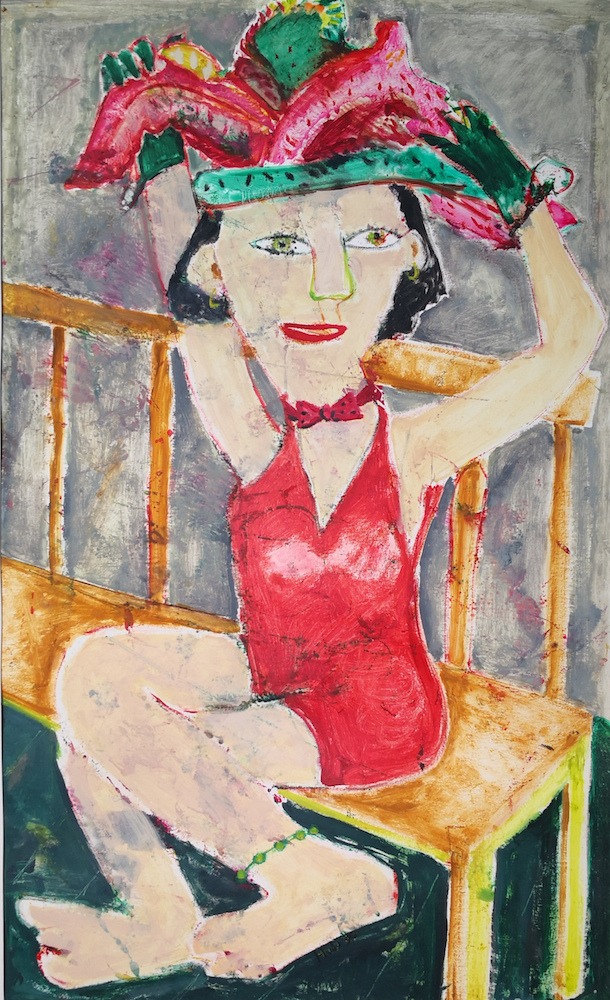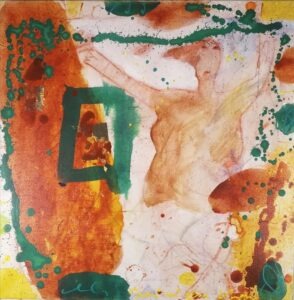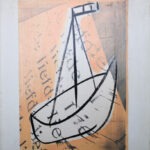COLLECTION ZOOM
Hennie van Diest
BIOGRAPHY
Born
1948 Den Haag
Residence
The Netherlands
Education
Royal Academy of Art, The Hague
The figures that populate the paintings of Hennie van Diest have the capacity to move.
They are not reflections of reality, they have nothing to do with it. They turn away from it, seem to emerge from a vacuum, an almost autistic world, in which man and animal are equated.
Hennie van Diest deliberately avoids dramatic images that warn of approaching disaster.
Her maxim “I paint to bring lightness into my existence” should not be seen as an attempt to escape the cruel reality of life and death, but merely to underline the pleasure of painting “to play with paint”. Her working method is analogous to her daily Tai Chi practice: emptying the mind through physical discipline with the aim of bringing body and mind into harmony. From this condition, the figures emerge naturally, which are slightly different, often with a small deviation, making a slightly helpless impression, painted with a mildly sarcastic undertone. This world belongs to her since her childhood, and this world and its manifestations are connected with her. Her work stems from a poetic power that seems to spring from the source of the imperfect, the vulnerable, the helpless. It is because of this that this unconscious recognition takes shape in a direct manner and is able to move people.
Hennie van Diest, who is a member of the BBK and Arti, studied at the Royal Academy of Art in The Hague. Many institutions own work by her and Hennie now has a large number of exhibitions to her name.
COLLECTIONS
AWARDS
EXHIBITIONS
MEDIA
ArtLending Voorburg in conversation with Hennie van Diest
Hennie van Diest
“There should always be something funny in it, a bit of humour”, says this artist of the month from The Hague. Her shining (blue) eyes reinforce the words. “Everything is allowed. An eye on a nose, for example, fine! As long as it has a ‘function’; it does something to you. Then I am satisfied.” At the dinner table, a spontaneous conversation about passion, art, the influence of emotion and (family) life begins.n.

Were you born and raised in The Hague?
“Yes, definitely. But I also lived abroad for a few years. In London, Paris; that’s what you do when you’re young.
The time in London, that was in the hippy era.”
Nice for sure, the hippie era in London – with the Beatles music?
“Yes, great!” exclaims Van Diest. “You met everyone in the ‘hippy atmosphere’. You understand, I didn’t want to go back to The Hague. At first, it was just boring here. Now I’ve been living in this house for 40 years.”
Can you tell us something about your work as an artist?
“I have come to realise that it changes.” Van Diest explains that after attending the KABK she worked differently than she does now. “When I came out of the academy I was a bit ‘wilder.’” From the kitchen table, where we are having a nice cup of tea, she points to a work on the wall. “You can see it’s a cup, but no more than that. I had no interest in reality, because I didn’t find that exciting at all. Imagine if I had to paint something. I would find that boring.”

Can you tell us something about your work as an artist?
“I have come to realise that it changes.” Van Diest explains that after attending the KABK she worked differently than she does now. “When I came out of the academy I was a bit ‘wilder.’” From the kitchen table, where we are having a nice cup of tea, she points to a work on the wall. “You can see it’s a cup, but no more than that. I had no interest in reality, because I didn’t find that exciting at all. Imagine if I had to paint something. I would find that boring.”

We know you at the art library for the voluptuous women you put on canvas with robust brushstrokes.
They are indeed quite realistic with a good dash of humour. Is humour important to you?
“Yes. I can’t paint without fun. I know that I shouldn’t work when I’m in a bad mood. Do you know what happens then? Then I use all sorts of dirty colours. I don’t want to work at all. Then I’ll put bright green and purple next to each other, for example – Hennie laughs heartily.”
Why don’t you paint men?
“Men I find less fun to paint. With women, you can do something crazy with the hair, or put on a cap. You can do that with men too, by the way. But I have less interest in them. It has nothing to do with my personal preferences, Hennie adds in passing. Men are nice if you want to put on some really nice muscles. Or if you want to portray a sturdy pose. I taught modelling for years. The men did well in that field. But women are still the best. It is easier to be playful with them.

How do you go about it?
“I start by applying paint. I work with oil paint and sometimes with acrylic. And then I start sweeping. You make something out of nothing. That process, that is beautiful. Looking is half the process. You look at the proportions, the composition, the lines and the colours. I need space.
In the studio, I constantly walk a few metres backwards to oversee the whole thing. I then look at the painting from a different perspective. If I don’t know what to do anymore, I put it away. Inspiration always comes, but you can’t force it.

Where do you get your inspiration from?
“When I see something really beautiful, it inspires me. I can’t say how it happens, but it does. What inspires me is diverse. The Nederlands Danstheater, that is world class. But I also like to visit museums. I used to love Henri Matisse, Klee, Rothko and some of the works of the Cobra group: Appel, Constant, etc., but also “outsider art”. Not everything, though. I have to look at each work individually. Some things are very much ‘just throw it on’. By the way, the other day I went to a theatre performance about Mondrian. There were actors juggling in net stockings. A beautiful image. You take that with you. I also like to hike in nature, to let go of everything. To relax. To create space for inspiration again, in fact.
What is the value of art?
“Another difficult question! You know, if art wasn’t there, you’d be missing an ‘extra dimension’ in your life. What I also find so beautiful is that artists go for something from their passion.”

Are passion and art intertwined?
“Yes.”
What would you have become if you were not an artist?
“Gosh. I would have done something with trees,” says Van Diest radiantly. “Still, nature, eh? You know, I was allowed to go to Wageningen University for further education. But I could not afford four, five years of study. What played a part is that when I was 21, I became a mother of a beautiful daughter. I started studying at the KABK with the idea that I could teach and be there for her during the school holidays. No sooner said than done. Incidentally, I am still happy with my choice of profession. If I don’t paint for a while, it doesn’t feel right. It is my expression.

Do you have a tip for a beginning (amateur) painter?
“Looking at a work is the most important thing. Doing your own thing is also more important than what everyone else thinks. And don’t forget: everyone is good at something, for example lines or colours. And talk to each other about the art. That’s what I enjoyed most about my years as a teacher of drawing and painting at the Korenhuis; talking to each other about art and sharing and passing on the inspiration.”
Do you have any exhibitions in prospect?
At the moment I am taking it easy. But of course I have put 50 small paintings (on paper) at the Kunstuitleen! I hope to be more active again soon. Take a look at my website!

At the end of the conversation, I leave for my bike, full of positive energy and inspiration. Van Diest is waving in the doorway and suddenly rushes out with a bicycle pump. “You had a flat tyre, come on, I’ll help you on your way. Van Diest is a treasure! In December, her colourful paintings – with a hint of laughter – were exhibited at the art library. Hang them in your living room and feel the vibe of Van Diest. Hope to see you there and to borrow!
Text and photos: Anne Schaap





